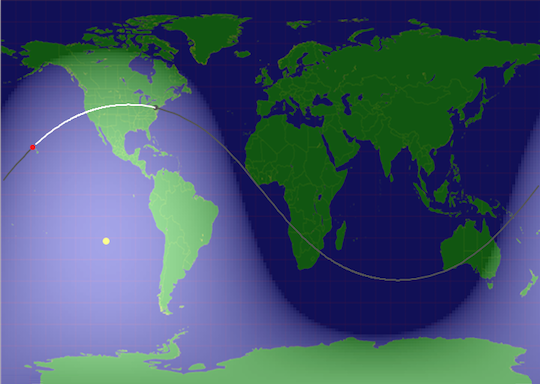I thought it would be interesting to see whether or not it was possible to crudely measure the speed of light using a shortwave radio and a time station.
Various time stations transmit precise time on several shortwave frequencies. Here in the USA, we have WWV in Ft. Collins, Colorado, which transmits on 2.5, 5, 10, 15, and 20 MHz. We also have WWVH in Kekaha, Hawaii, which transmits on 2.5, 5, 10, and 15 MHz. These stations transmit an audio “tick” at exactly each UTC second.
One way to measure the speed of radio waves (and light) would be to measure how long it takes for the tick to travel a fixed distance. Divide the distance by the time, and we have the speed of light. However, that requires knowing the exact UTC time locally. While this can be done with a GPS unit that outputs a 1 PPS (pulse per second) signal, I thought it would be more interesting to do it using just a shortwave radio without any extra hardware, other than a computer to record the audio.
Both WWV and WWVH transmit on several of the international time frequencies. And it turns out that at certain times of the day, it is possible to receive both of them on the same frequency. The following recording was made on 15 MHz at 1821 UTC on January 1, 2011: Recording of WWV and WWVH
You can hear the time announcement for WWVH first, by a woman, followed by a man giving the WWV time announcement.
I am roughly at a location of 77W and 40N. WWV is located at roughly 105W and 41N, and is about 2,372 km away. WWVH is located at roughly 160W and 22N, about 7,883 km away. The actual path the radio waves takes to reach me is longer, due to the fact that they reflect off the ionosphere, a few hundred km high. We’ll neglect that for now.
The difference in distance between WWV and WWVH is 7883 – 2372 = 5510 km.
The following is a display of the waveform from the above recording, centered around one of the second ticks. You can see the stronger WWV second tick centered at about 19.086 seconds into the recording. You can also see the weaker WWVH second tick centered at about 19.105 seconds: 
The other waveforms you see before and after the second ticks are the audio that each station always transmits.
If we subtract the time markers for the two ticks, we get 19.105 – 19.086 = 0.019 seconds (19 milliseconds). That’s the time delay between the two ticks. Next, performing our division, 5510 km / 0.019 seconds = 290,000 km/second. The generally accepted value for the speed of light is 299,792 km/second. That’s pretty close!
In all fairness, the time resolution is not that good, and I had to eyeball the readings. Plus, a one millisecond difference in the time delay would have resulted in about a 15,000 km/sec difference in the speed of light. So a slight difference in eyeballing these broad time ticks would result in a large error in our estimate of the speed of light.
If you listened carefully to the recording, you no doubt heard a fluttery or watery quality to the sound. This is often indicative of multipath, where the radio waves take two (or more) paths between the transmitter and receiver.
Here’s another waveform from the recording, centered at 27 seconds into the recording: 
In this case, we can clearly see the second tick from WWVH. But there’s no second tick from WWVH, just silence. Where is it?
Looking further into the recording, we see another second tick delayed much further. Eyeballing it, the delayed tick is at about 27.187 seconds into the recording. And the first tick, which we believe is from WWV is at about 27.087 seconds. The difference between the two is 0.100 seconds. Using the accepted speed of light, this difference in time could be due to a distance of 299,792 km/sec * 0.100 sec = 29,972 km. What could account for this delay?
One possibility is that during this time period, the signal from WWVH was not taking the normal or short path to my location, but was instead travelling around the other side of the Earth, taking the long path.
The circumference of the Earth is about 40,075 km (the exact value depends on which path around the Earth you take, as the Earth is not a perfect sphere). We know the short path is 7,883 km, so the long path is about 40075 – 7883 = 32192 km. There is still the delay due to the time it takes the radio waves to get from WWV to my location, that path is 2,372 km. The net difference between the two is 32192 – 2372= 29820 km.
We can divide that distance by the speed of light to see what the time delay should be: 29820 km / 299792 km/sec = 0.099 seconds. This is extremely close to our measured period of 0.100 seconds, and suggests that the long delayed second tick really is from the WWVH signal taking the long path around the Earth to reach us.
The following map, generated with the DX ToolBox Radio Propagation Forecasting Program, shows both the short path (white line) and long path (gray line) between my location and WWVH: 
Comments appreciated!


Chris;
This is very cool! On one hand, it is amazing that the average guy nowadays can use common and relatively unsophisticated tools to obtain quite precise measurements on fundamental physical constants such as this.
And it also reinforces the respect we have or should have for pioneers such as Michelson who had to cobble up a test setup to obtain their results.
“The actual path the radio waves takes to reach me is longer, due to the fact that they reflect off the ionosphere, a few hundred km high. We’ll neglect that for now.”
I get how in your first measurement, this effect nearly cancels out like you’re adding x to both sides of an equation.
I’m not so clear on how this works for the second part of your experiment, when one signal travels most of the way around the world.
First class experiment using ultra-simple methodology.
Pingback: Measuring The Distance To A Shortwave Radio Station | HFUnderpants.com